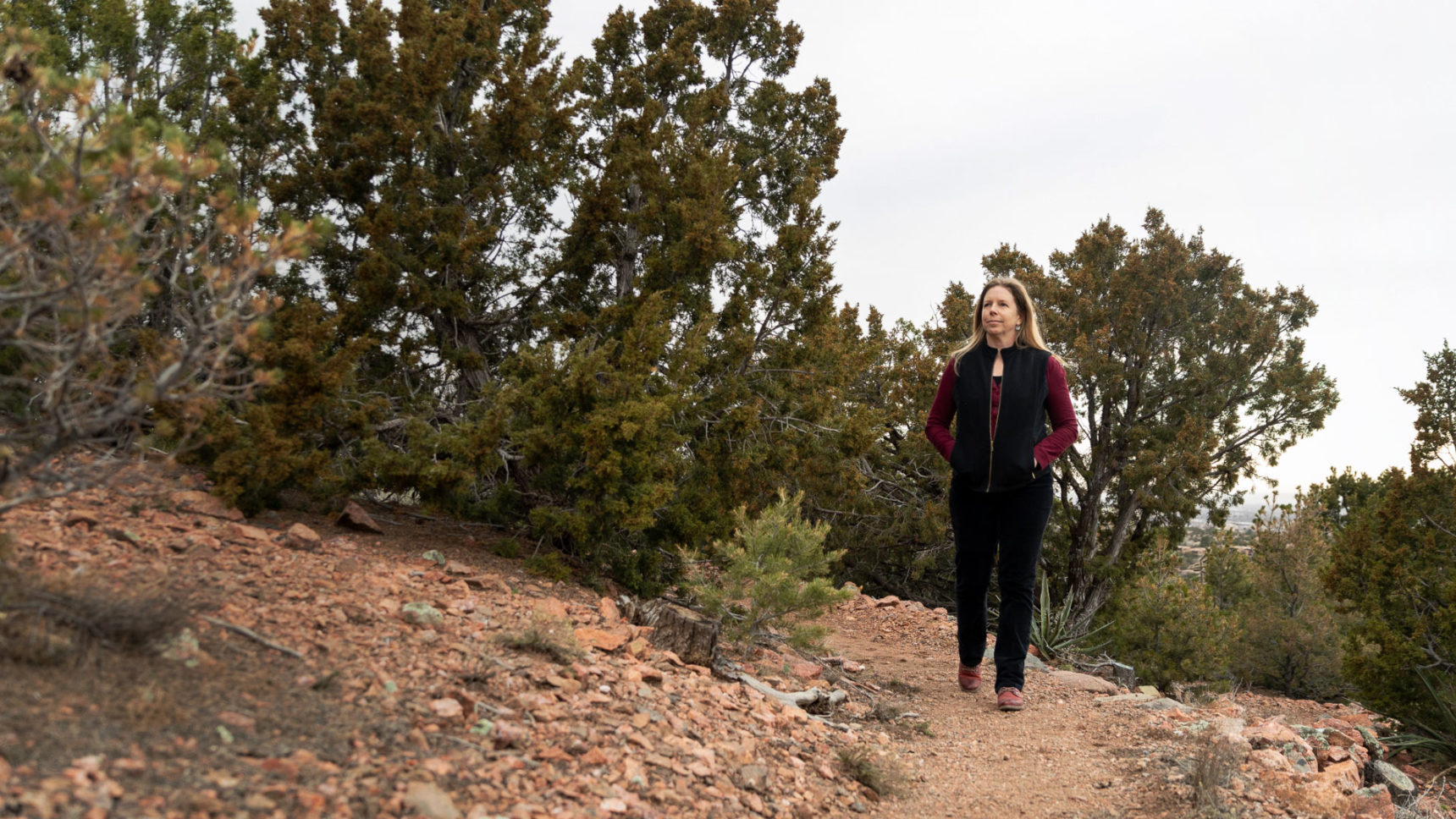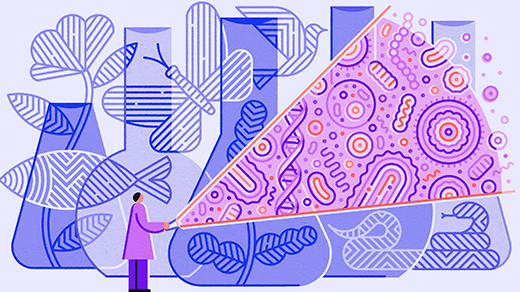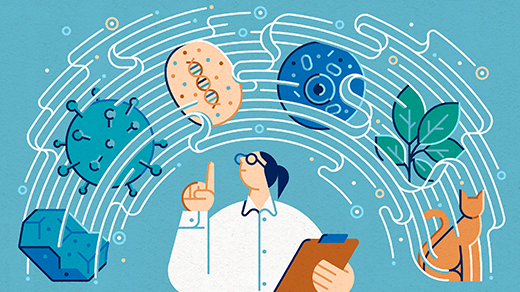She Finds Clues to Future Sustainability in Old Food Webs
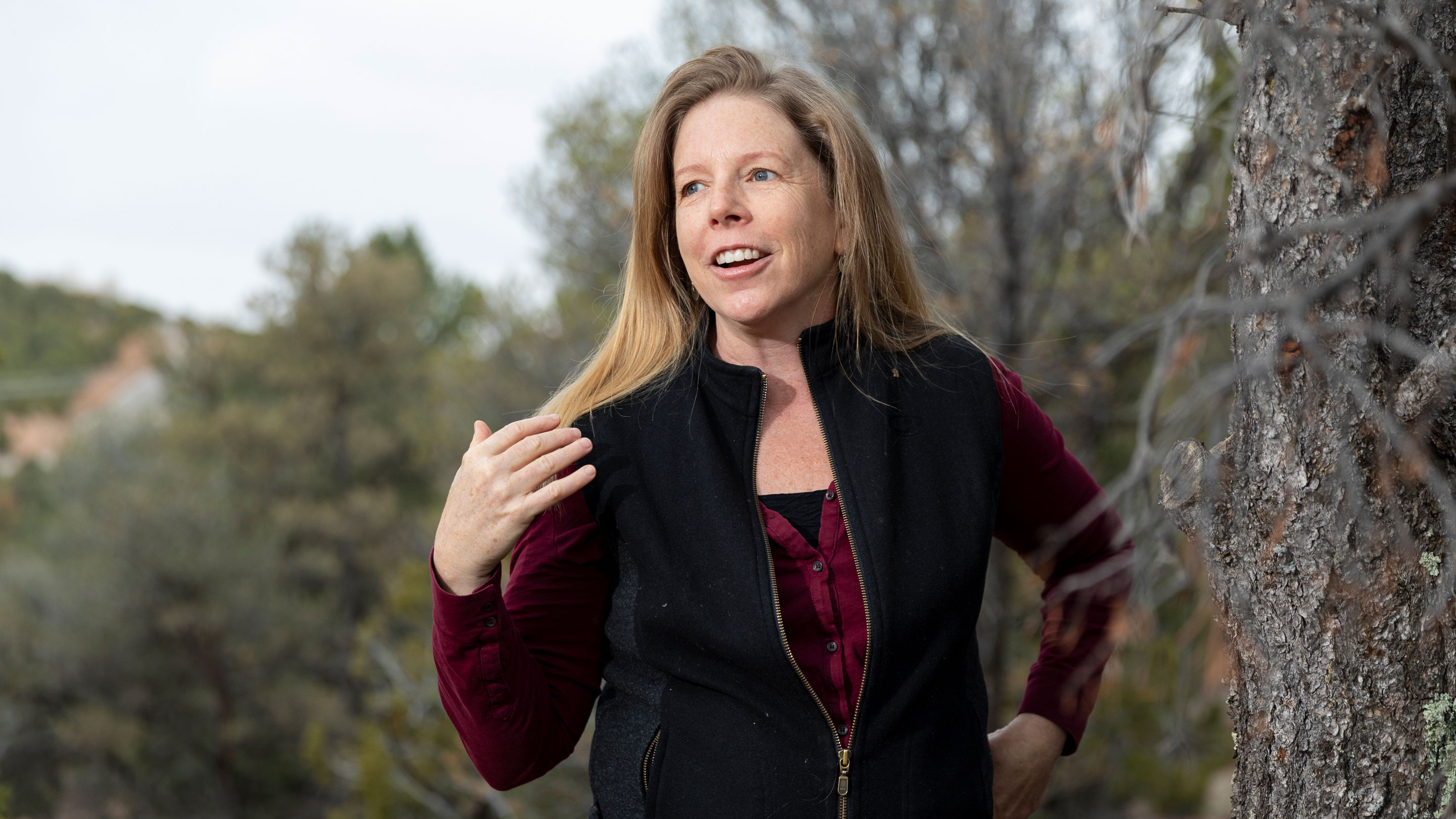
The ecologist Jennifer Dunne explores the networks of interconnections among species in ecosystems. For most organisms, those connections are defined by the food web of who-eats-whom, but for humans the range of uses is much wider.
Gabriella Marks for Quanta Magazine
Introduction
On a grassy hill near where I met the ecologist Jennifer Dunne at the Smithsonian National Zoo, a lion craned its shaggy head back to watch a helicopter fly over. It was a stark illustration of humans’ unusual place in the ecosystem. Generations ago, that lion would have hunted us; today, children watch it from behind a fence. But we haven’t removed ourselves from the world’s food webs, Dunne says.
“Ecologists tend to study ecosystems ostensibly in the absence of humans,” she said. “Of course, humans are everywhere and impact everything.” When ecologists do consider humans, Dunne added, they often treat us as an external factor causing something like climate change. Throughout history, however, we’ve been enmeshed in the planet’s networks of life-forms eating one another.
Dunne, who is vice president for science at the Santa Fe Institute, arrived at food web research after starting out in plant ecology. By painstakingly cataloging every species in an ecosystem and what it eats, Dunne and her colleagues can quantify an entire food web. In their data visualizations, every species in a food web — from plankton to panthers — is reduced to a little ball, or node, and every feeding interaction becomes a line between them.
Those nodes don’t have to be alive today. Dunne has worked on several prehistoric food webs, including one represented in the 500-million-year-old Burgess Shale. To figure out feeding relationships among its weird, impossibly old fossil creatures, she and her co-authors looked at fossilized gut contents and bite marks for clues. They found that the structure of the ancient Cambrian explosion’s food web had remarkable similarities to that of food webs today.
In 2016 Dunne co-authored the first comprehensive, detailed food web that explicitly included humans. That paper looked at the Aleut people who inhabited Alaska’s Sanak Archipelago for thousands of years. Since then, she and other researchers have described food webs that include humans from other ecosystems, both past and present-day. While they built these food webs, Dunne and some of her ecologist and archaeologist colleagues also started brainstorming about other ways to explore how humans have interacted with ecosystems throughout history.
They arrived at the idea of a new kind of network: not a food web, but a web of use. Their working group, which first came together in early 2017, looks at six populations of preindustrial or nonindustrial humans, cataloging every way that people interacted with the species around them: pelts for clothing, wood for shelter, leaves for medicine and so on. To visualize the results, the researchers map a culture’s five or six most-used species onto a circular plot, along with a “taxonomy of uses.” The result resembles a thickly woven dreamcatcher.
Every studied group has a unique story. They encountered different ecosystems and climates and had different cultural practices. Some were hunter-gatherers, some grew their food, some tended animals. The ancient Polynesians, for example, arrived with species such as chickens, coconuts and hitchhiking rats, bringing “their own little food webs in the canoes with them to the Polynesian islands,” Dunne said. Some groups were flexible; others had firm ideas about what they would and wouldn’t eat.
By teasing apart these stories, Dunne and the rest of the group hope to start to understand what makes a human civilization sustainable or not. “This whole research agenda is quite new. No one’s tried to do it before,” she said. An edited and condensed version of our conversation follows.
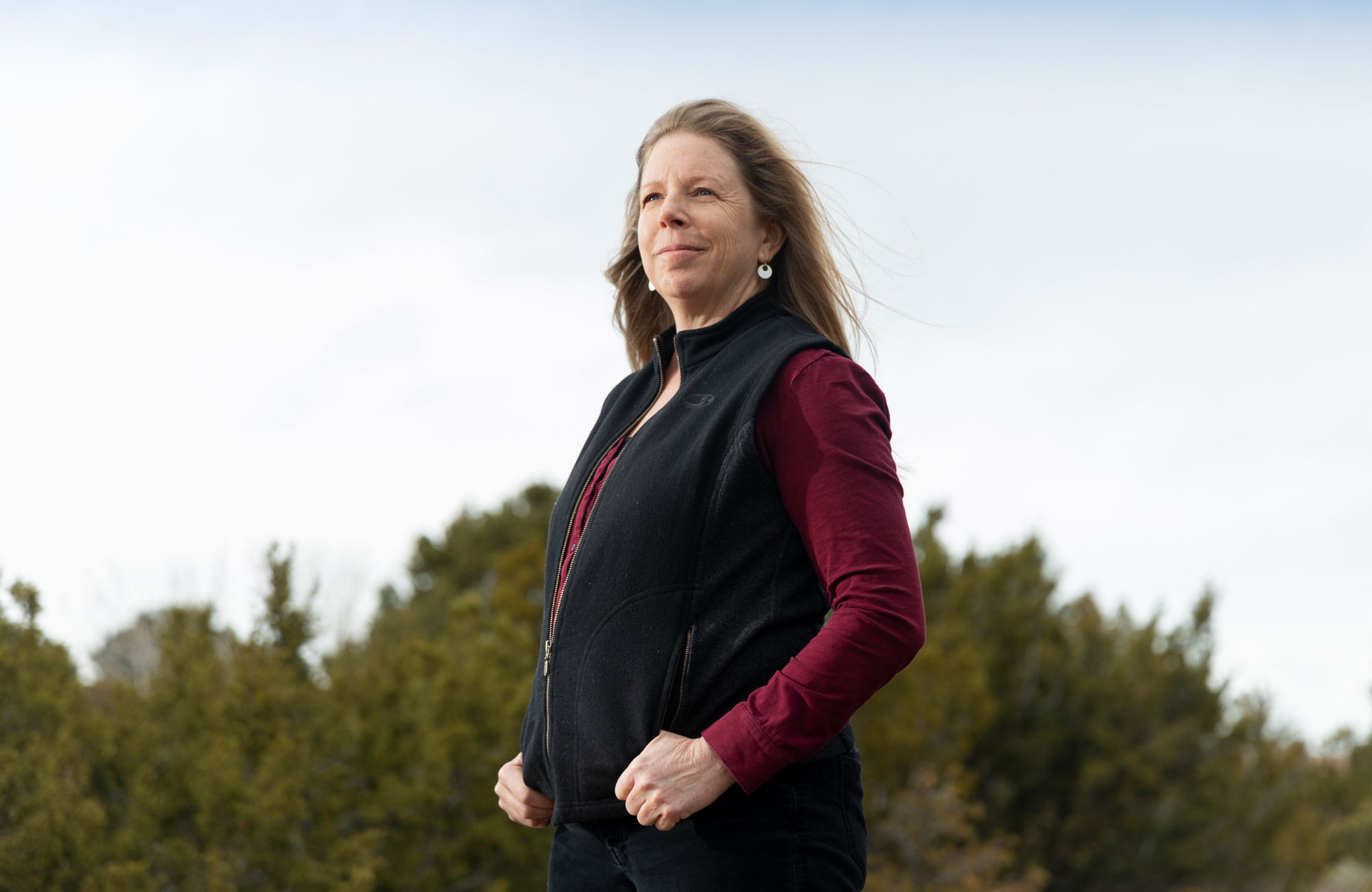
Gabriella Marks for Quanta Magazine
When you build a food web, does it only entail figuring out every single species that’s in a place and then connecting the dots between them?
At its simplest, that is exactly what a food web is. Get as detailed a species list as you can, and then figure out what each species eats out of that list. That sounds simple in principle. In practice it’s very hard!
In terrestrial systems, for example, we often don’t know much about the insects. Or you can have more detailed information about what species are there, but you may know nothing about what they eat, apart from “this insect eats plants.”
When you constructed the Burgess Shale food web, it seemed to come down to what can fit its mouth around what.
Right, exactly. In every paleo food web that I’ve been involved with, basically every link is a hypothesis of a feeding interaction. Then it’s annotated with one or more lines of evidence. Based on the evidence, we assign it a certainty level. That makes it easier for people down the line to reevaluate and tweak it. They’re living, breathing data sets. It’s not like we ever have a perfect understanding. It’s just a representation.
So tell me about these food web visualizations. They all kind of look like layer cakes.
In those food webs, the vertical axis has ecological meaning. That’s trophic level. At the bottom you have primary producers, like plants or algae, which make their food through photosynthesis. That’s trophic level 1. The next layer is herbivores, things that eat only primary producers. That’s trophic level 2.
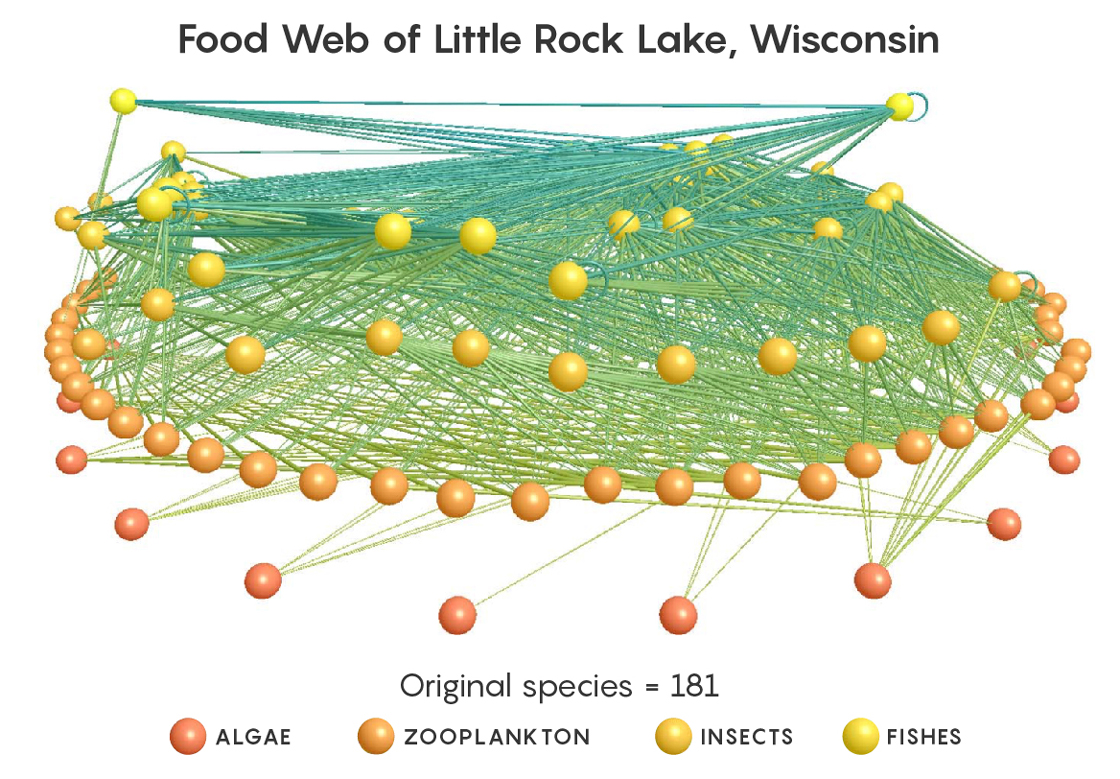
This “layer cake” diagram represents the food web documented in one Wisconsin lake. At the bottom are the primary producers, such as photosynthetic algae, that make up trophic level 1. Other organisms occupy higher tiers, depending on the average length of the individual food chains that connect them to primary producers.
For something above an herbivore, you follow all the different food chains that connect it to a primary producer, and then you do an average over those. If, say, something only eats herbivores and doesn’t eat plants, then it would be at trophic level 3, because it’s two steps away from the primary producers. But many things that eat herbivores also occasionally eat a plant or an alga. They’re omnivorous, which means they’re eating at different trophic levels. So almost everything above herbivores has a fractional trophic level, for example, 2.5.
Once you have the layer cake, what can you do with it? What does that shape tell you?
Basically, that shape gives you one way of characterizing the architecture of ecosystems. When you have that data, you can visualize it in compelling ways and evaluate it for different properties. Like, what fraction of things in the system are humans feeding on, and how does that compare to other consumers in the system?
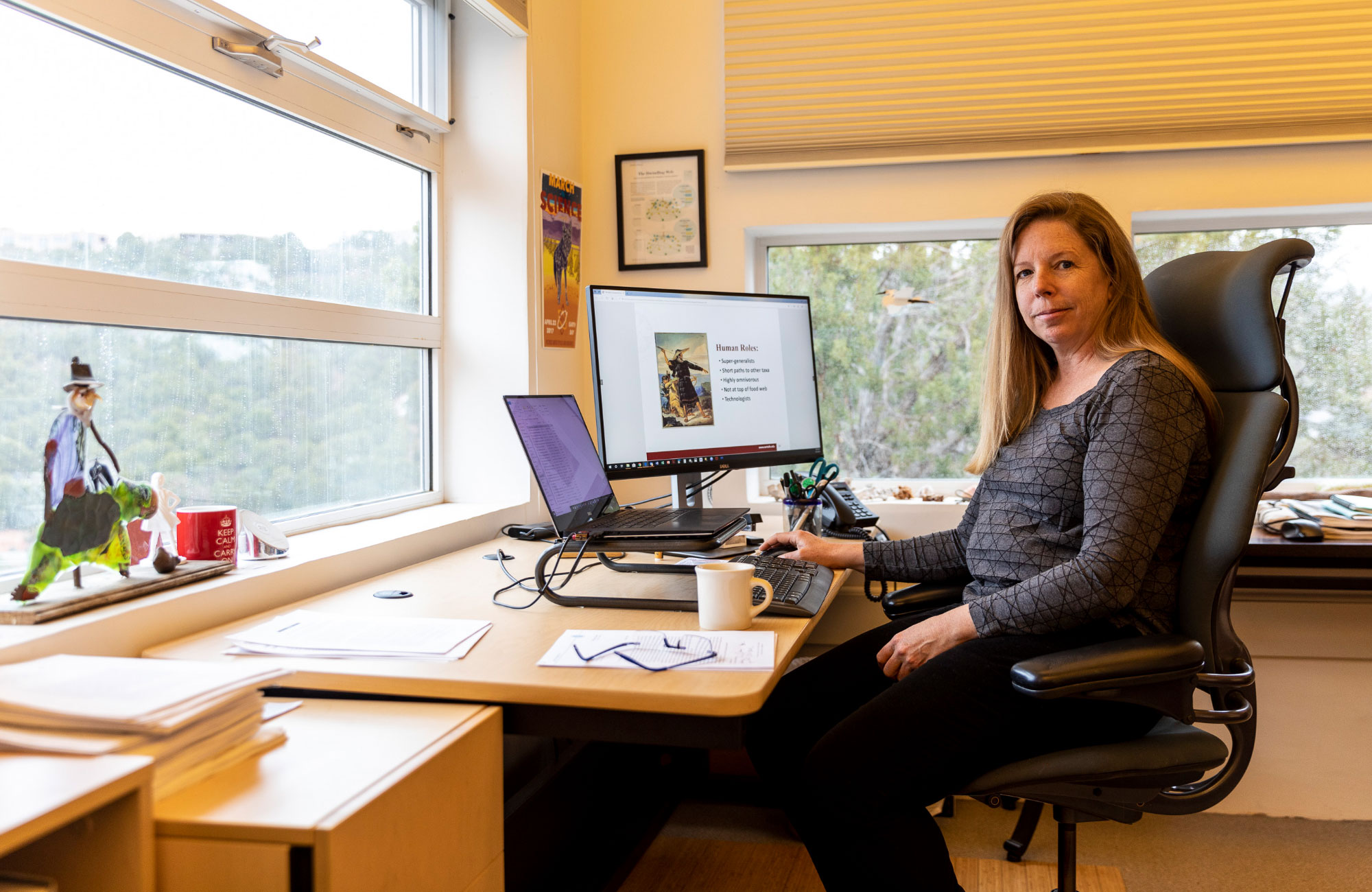
Jennifer Dunne in her office at the Santa Fe Institute, where she is vice president for science.
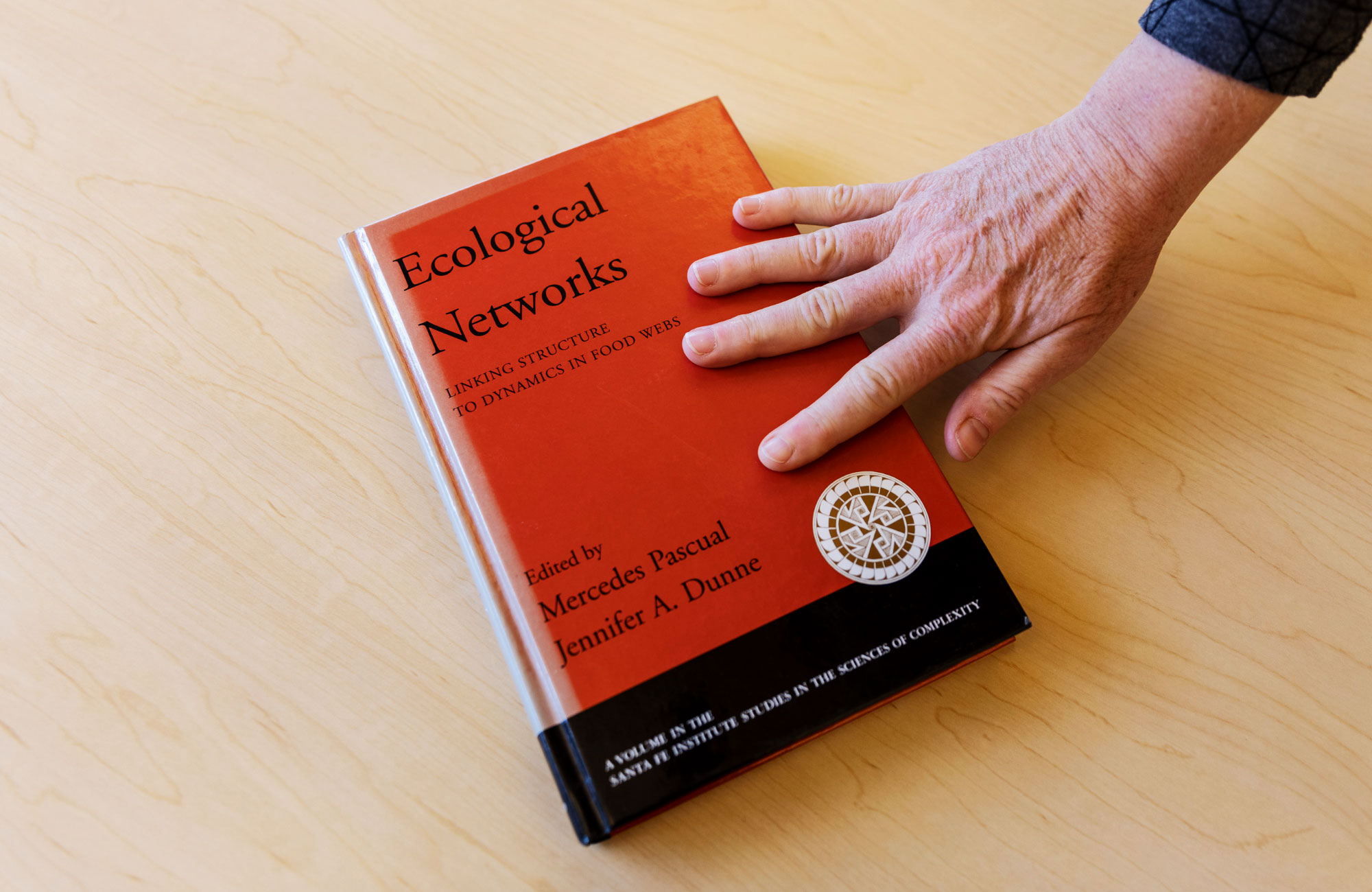
Her work on using the networked structures of food webs to gain insights into the dynamics of species interactions within ecosystems has been immensely influential.
Jennifer Dunne in her office (left) at the Santa Fe Institute, where she is vice president for science. Her work on using the networked structures of food webs to gain insights into the dynamics of species interactions within ecosystems has been immensely influential.
Gabriella Marks for Quanta Magazine
So what have you learned about humans’ place in food webs?
Humans are very omnivorous — and because of that, they are not at the top of the food web. Humans are usually kind of in the middle to upper third of the food web for the few systems that I’ve studied. People tend to think humans are at the top. Well, humans are often at the tops of their individual food chains, but because they’re eating everything from plants all the way up to top carnivores, they end up being in the middle of the whole food web.
Of course, all that’s ignoring parasites and viruses. I have separate work on including parasites in food webs, but that’s a whole different story. But if you ignore parasites and viruses and our microbiome, humans are generally at the top of food chains now. In premodern times, other things would eat us. That’s not so much the case anymore.
Humans also have short path lines to other species. They have basically two degrees of separation from over 90 percent of the species in the food web, to put it in “Kevin Bacon” terms: Often they’re directly feeding on a quarter to 50 percent of the species, and then almost everything else is connected to those species. So within two links you can get anywhere.
Does that make us special as a species?
In the systems I’m looking at right now, humans are super generalists. They feed on many more things than almost all other species.
In any food web, most animals are fairly specialized in what they eat. Most eat 10 or fewer things. You have a few things that eat more and more. And then out at the very end of the long tail of the distribution is where humans tend to be. In a sense, that is special.
However, there are always some kinds of generalists in a system. I mean, in the case of the Sanak Aleut nearshore marine food web, there are two super generalists: us and cod. Pretty much anything cod can stuff into their mouth and take a bite of, they do.
That makes me feel less special.
Right! I expect that’s not always going to be the case. One of the open questions is, how general is that pattern? Each of the systems I’m looking at is quite different, and the humans have access to different kinds of species. But they’re still ending up as super generalists.
Humans are very flexible. That’s one of our characteristics. We’ve spread all over the world, and we’ve been successful at invading and becoming a part of many different kinds of ecosystems. That’s really what we want to get at with this new project — thinking about all the ways humans interact with species.
How is the new project different from the food webs you’ve made before?
The food webs show all the species in a system and one kind of interaction between them, which is feeding. With these human-use webs, we’ve reduced it to focus only on all the links to and from humans. But instead of just doing feeding, we’re expanding out to many categories of interaction.
These interactions can be simple or complex. One example is from the Nuu-chah-nulth people of the Pacific Northwest Coast in Canada. (In talks, I use a painting of Tlingit women eating berries to illustrate this point, but our data are from the Nuu-chah-nulth.) You’ve got the humans, and whatever the species of berry is and the link between them. It’s very simple — two nodes, one link: They wander out into the woods and gather berries.
In the same system, humans eat whales. Two nodes, one link, totally different story! This huge complex of many species and many types of interactions is required for humans to successfully hunt, kill and eat the whale. You have to make a canoe, which is a complex technology in and of itself. You have to use a dozen different plant species and 10 different animal species. You have to make all the things that go along with canoeing, like air bladders. You have to make spears and protective clothing for yourself. The Nuu-chah-nulth people go through rituals to make sure the hunt is likely to be successful. And then they have to haul the whale back to the beach and cut it up and do more rituals, and they may or may not prepare the meat or blubber in different ways.
That’s probably the most complex of the complex interactions. But many things are like that.
What new insights can you gain from this analysis?
It’s providing new kinds of species-interaction data centered around humans, which give us access to this slew of interesting ecological, cultural and socioecological questions. And it gives us a new way, I hope, to think about sustainability. We’re studying some systems that had bad environmental outcomes, like species loss and environmental degradation, and also human cultural chaos or breakdown. Are there lessons for thinking about sustainability, now and into the future?

This kinetic sculpture by the local artist Michael Schippling hangs on Dunne’s office wall. Dunne sees such works as creative examples of complex systems — the special focus of the Santa Fe Institute — and a reminder of the intricate networks of connections linking humans to the rest of nature.
Photo: Gabriella Marks for Quanta Magazine; art: Michael Schippling
There’s an example that was recently written up by a member of our working group, Stefani Crabtree of the Santa Fe Institute and Utah State University, and her colleagues. In the Western Desert of Australia, the Martu Aboriginal people have been a part of that ecosystem for many tens of thousands of years. There is no system without the Martu. But the modern Australian government decided to pull them off that land. The Martu were setting small-scale fires to enhance their ability to hunt large-bodied lizards, and once they were pulled off the land, very quickly it messed up the ecosystem. You have extinctions of small mammals; you have massive wildfires that start because no one is doing this patchwork mosaic burning. So now the Martu are going back onto the land and starting to do their traditional burning practices, and that’s helping to restabilize the system.
But then in the case of the Sanak Aleut, who came into the Aleutian Island system 7,000 years ago, there’s no apparent disruption. There’s no known short- or long-term local species extinction. They were able to fit in and become a part of the ecosystem.
So what makes an ecosystem fall apart versus keep going for 7,000 years?
The Sanak Aleut were poised to play potentially destructive roles as highly omnivorous super generalists. They brought hunting technology, which lets humans feed at a greater rate than you would expect from animals of their body size. But humans also have characteristics that allowed these super-generalist omnivores with hunting technology to come into the system and not wreck it.
One was that, like other generalist feeders, the humans could and did prey switch. Generalists may feed on a lot of different things in a system, but they tend to focus on a very few things at any given time. The Sanak Aleut’s preference was to hunt sea lions, but most of the time they couldn’t do that. The weather was terrible. They couldn’t launch their kayaks. And so they would go gather stuff in the intertidal, focusing on big, juicy things first. Then when the salmon came in, they would drop everything else and go harvest salmon. So they were constantly switching.
One of the effects of prey switching is that it allows the previous prey species to recover. We know from dynamical modeling that that’s very stabilizing in terms of coexistence and persistence of species.
The Sanak Aleut also weren’t using all their hunting technology all the time. They had fancy tech for getting in kayaks and hunting sea lions, but most of the time they weren’t doing that. They were just going out and gathering stuff.
Is there a prey-switching analogy for the present day?
There’s an anti-prey-switching analogy! Bluefin tuna is an example I use a lot. Bluefin tuna are in very high demand in the international sushi market, so they get hunted commercially. As they’ve become more rare, they’ve become more valuable.
You get this perverse anti-ecological dynamic. In an ecological system, as something becomes rarer and harder to find, its ecological value goes down. That’s why predators prey switch: They have to expend too many calories to try to get that prey, or it’s too dangerous. But in a luxury market, all of a sudden you get the perverse incentive to hunt more because it’s worth more and more money. A bluefin tuna was just sold recently for more than 3 million dollars, a new record.
It’s bad for the bluefin tuna, right? But that also introduces a bad dynamic into the whole system. It’s destabilizing — not just for bluefin tuna but potentially for the whole food web. The tuna are embedded within a whole network of interactions.
And that’s part of the point of doing food web research, or interaction research. You pull out one node, you pull out one interaction, and it’s not just about those species. It’s about impacts that can potentially ripple throughout the whole system, and often in unexpected ways.
